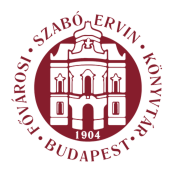Buza Péter - Gadányi György: Towering Aspirations - Our Budapest (Budapest, 1998)
14 Károly körút, district V The first generation of the Szevera family had come to Hungary, gaining full citizenship of Pest, in the 18th century from the far-away land of Italy, where it had earned its living through cooking meat for salami. (Salami was cooked according to a mediaeval preservative recipe surviving into modern times. The Italians were the best known practitioners of the method throughout Europe.) On arrival in Pest they chose the lively neighbourhood of the Orczy House by the corner of what was later to become Király utca to take up residence and open their first shops. It was in these establishments in the huge building on the corner of Király utca, a block that was, incidentally, rented mainly by Jewish tenants, that János, a member of the third generation and operating as a “central caterer to the military”, that is in the enviable capacity of court supplier, continued the family business. Another Szevera, Károly, carried on the tradition as a wealthy butcher. The fact that in the early 1880s the Szeveras eventually bought a house and moved to the other side of the road indicates a change in their fortune whose significance cannot be overrated. This side of the road belonged to the city itself, which had, not so long ago, been separated by a wall from the mixed population of the outlying areas including the town’s outskirts, which started with Király utca. It was an old house on the plot at No. 20 of today’s Károly körút that János and Károly, the two Szeveras, bought as a first step, from which location Károly pushed even further inwards when he purchased, in 1899, the house at today’s No. 14 from the inheritors of Loser the grocer, which dilapidated building he had pulled down to have a sumptuous new house built in 1900-01 by the best craftsmen available. Four glass mosaics decorate the fagade (according to unsubstantiated expert hypotheses the allegorical presentation of spring, summer, autumn and winter are attributable to Miksa Róth’s workshop) and strange, magical-looking towers characterised by a dynamism comparable to those on the Museum of Applied Arts provide exciting embellishment for the roof level. The as yet unidentified artist responsible for the fagade and the building itself must have been very closely related to the school of Ödön Lechner, grand master of Hungarian Art Nouveau. 38
